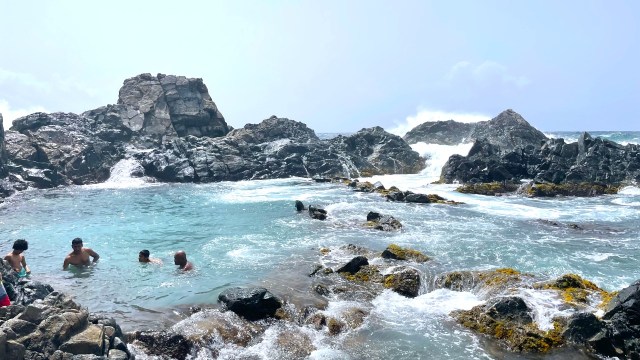If you’re not a seasoned traveler to the Caribbean, you may be under the impression that no matter which island you choose to visit, you’ll likely have the same experience: white sand, sun, crystal blue waters. Aruba, an island in the Lesser Antilles of the region has all that, but many of its features make for a different kind of Caribbean getaway for families. We checked it out for ourselves and and the full scoop on the best things to do in Aruba with kids.
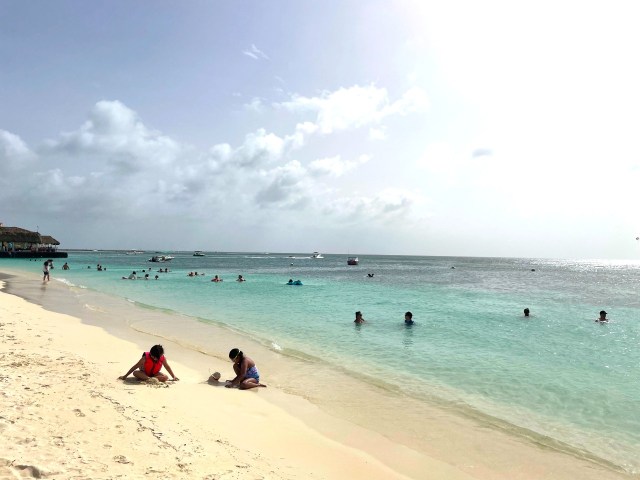
Aruba Is Near the Equator—and Dutch
Aruba is probably farther south than you think: it’s off the coast of Venezuela. Yes, that means a slightly longer flight (from New York it’s about four-and-a-half hours; from Miami, it’s under three) and a little more squirming and iPad time for the kids, but there’s a payoff. (See: “The Weather.”)
The official language of the island is Dutch (laws are in Dutch, school is taught in Dutch), but many residents also speak the native language of Papiamento, English and Spanish.
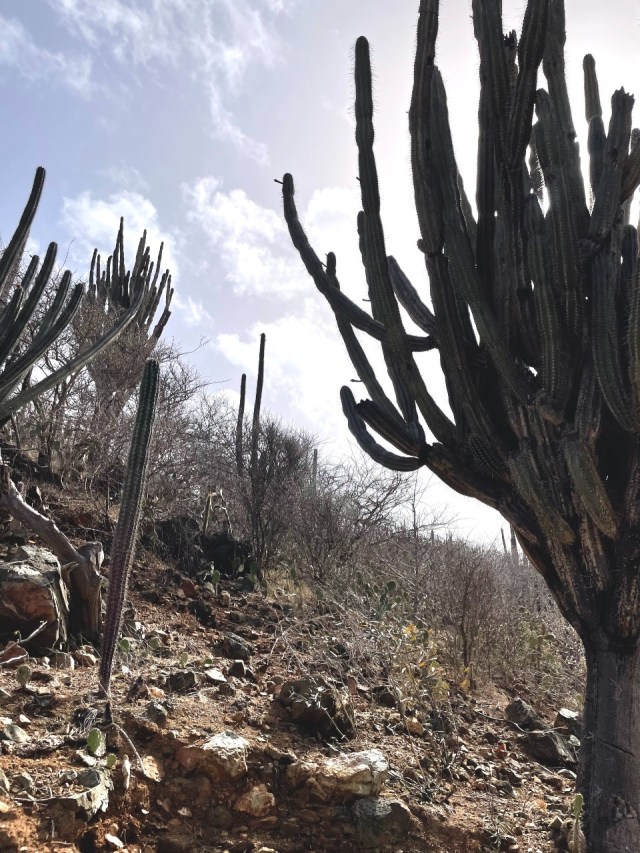
The Weather & Climate Are Probably Not What You Expect
Key point: Aruba’s location places it far outside the hurricane belt, so a major storm event is unlikely to force you to cancel your trip. In addition, the island does not experience a “rainy season,” which means there really isn’t a bad time to go. It’s essentially about 80 degrees all the time in Aruba, and while a lot of Caribbean islands are quite humid, the climate here is more arid. Think less tropical (like Florida); more desert, like Arizona. Cactuses abound. Mitigating the heat, however, are the near-constant tradewinds from the northeast. The breezes not only keep things cool but cause the trees, including Aruba’s iconic Divi Divi tree, to grow leaning southwest.
Tip: Aruba is about 12 degrees north of the equator, which means the sun is very strong. The result is that it’s very easy to get a bad sunburn here—even in the shade. Sunscreen is a must, and it should be labeled “reef-safe.”
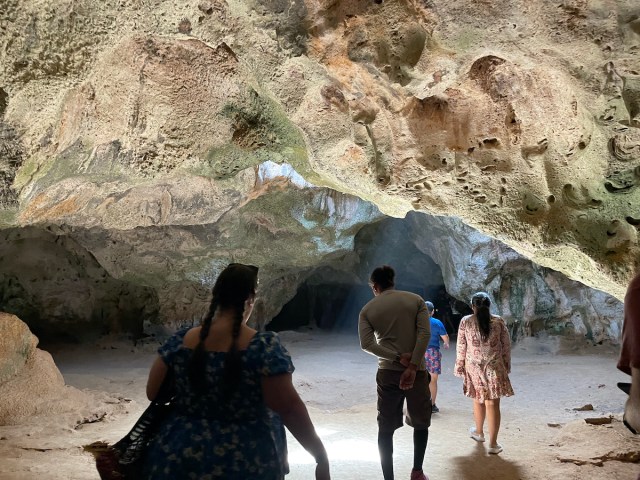
Family Fun Beyond the Beach in Aruba: Caves, Ostriches and Aloe
A big reason to visit Aruba is all that sun, sand and surf (the last of which is clear blue and a perfect temperature for swimming). But when you’re ready to leave the beach, you have lots of options.
De Palm Island
Make a trip to De Palm Island for an all-inclusive day of fun. Admission ($95/kids; $119/adults) gets you six-hour access to a water park, thrilling water slides, a buffet and open bar, snorkeling equipment (with lessons), banana boat rides and three beaches with various shelters for shade. Additional experiences like “Sea Trek” ($49, ages eight and up) and “Snuba” ($39, ages eight and up) provide ways to be among the undersea creatures without the gear or certification required for actual SCUBA diving.
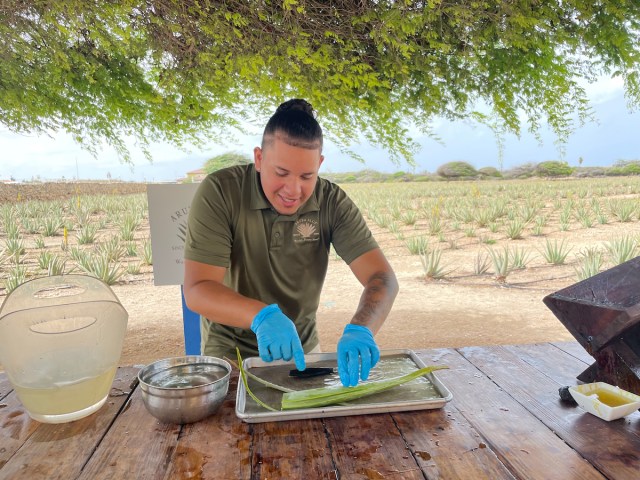
Visit Aruba’s Farms, Flora & Fauna
Take your pick from the Aruba Ostrich Farm where you can meet, learn about and even feed the big birds; The Butterfly Farm (a similar experience to enclosed habitats in the U.S.; a single ticket gets you unlimited admission) or the farm and factory of Aruba Aloe. Aruba Aloe has a huge presence on the island (it’s everywhere) and during a quick tour at HQ you learn about the plant, how it is harvested and see the production and packing of products on the factory floor. Plus: huge fields filled with Aloe plants, a striking sight.
Heads up birdwatchers: Visit the Bubli Bird Sanctuary’s observation tower for a chance to see some of the 80 migratory birds that roost and breed here, including herons, egrets, gulls, ducks and skimmers.
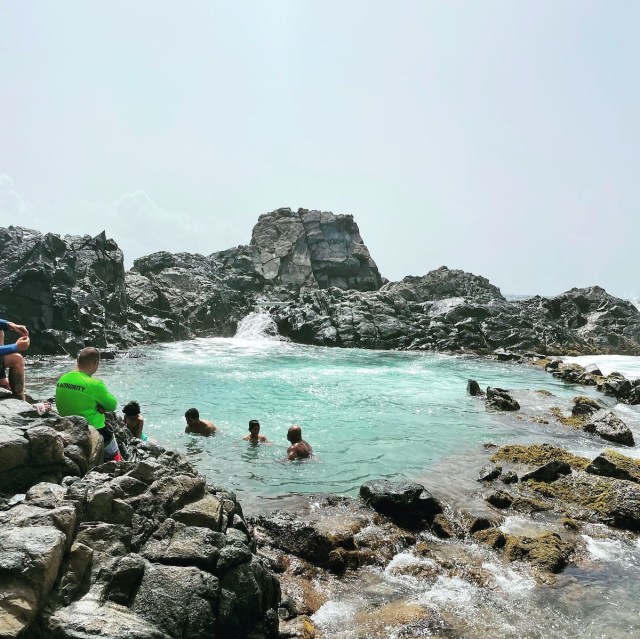
Arikok National Park: Buckle Up for an Off-road Adventure
A trip to Arikok National Park is a must. In addition to hundreds of cacti, the park’s features include super cool caves, with actual bats flitting around; a natural pool on the coast, where you can take a dip, and natural bridges formed from coral limestone. (The famous natural bridge on Aruba collapsed in 2005, but its smaller counterpart at the same location remains.) Be prepared for a bumpy ride to get to some spots; our guide from De Palm Tours was excellent, but it’s rugged terrain.
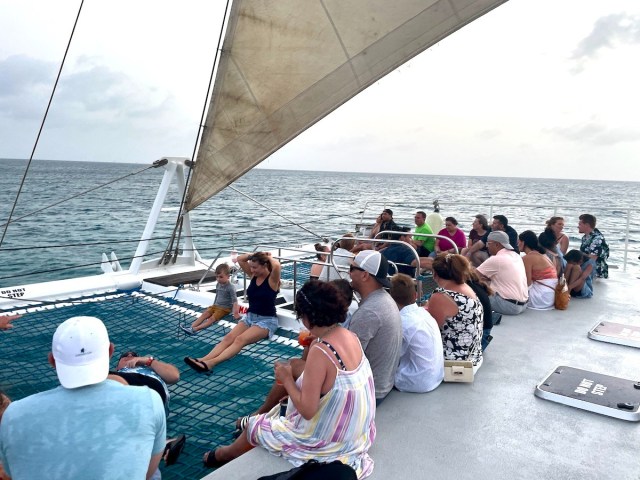
Take to the Water
Aside from taking a dip at the beach, you have lots of options when it comes to exploring the Caribbean Sea. De Palm Tours operates both semi-submarine and submarine tours, during which you can view the Arashi Coral Reef, sea life, the largest shipwreck in the Caribbean and World War II German freighter Antilla. (Passengers on the submarine Atlantic must be at least three feet tall and four years old.)
De Palm also offers excursions on the Palm Pleasure catamaran (shown above), including daytime snorkeling and sunset sails. (Sunset sails can have a reputation for morphing into a rowdy “booze cruise.” The one we took was festive but not a free-for-all, and had many families with small kids aboard.)
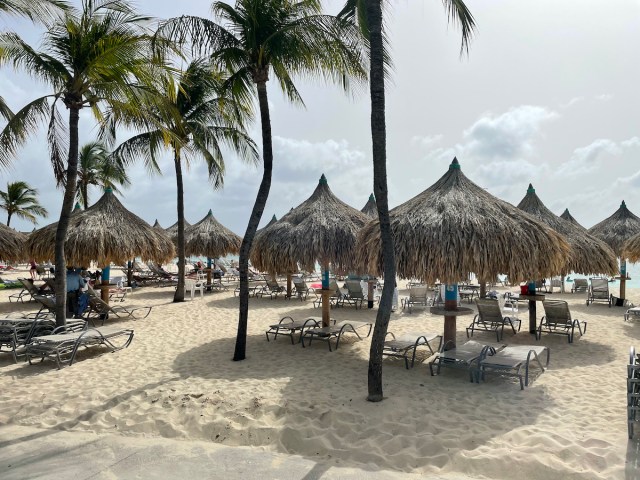
Where to Stay
If you’re headed to Aruba, chances are you are hoping to spend a fair amount of time near and at the beach. You’ll find two kinds of beachside resorts in Aruba: Low-rise and high-rise.
Low-Rise Choices
The low-rise properties (which true to the name, are only a few stories high), are found in Eagle Beach. This area tends to be favored by honeymooners and those looking for a quieter, more secluded stay. The Bucuti & Tara Beach Resort is a popular choice, and it is, like many properties here, adults-only. Family-friendly options in this area include numerous timeshares and vacation rentals.
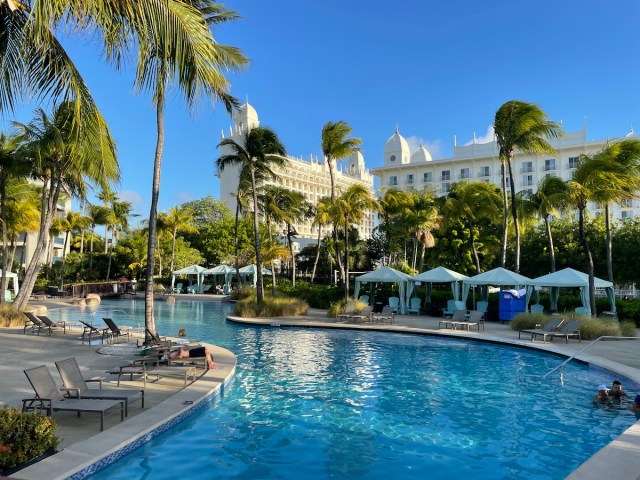
High-rise Choices
The high-rise resorts are located in Palm Beach, the more lively and glamorous area of the island. The advantage of staying in Palm Beach is that it is incredibly convenient. The main drag of J.E. Irausquin Boulevard, with shops, restaurants and nightlife is right outside your door. The Ritz-Carlton and The Hyatt Regency are among the major brands operating hotels here.
We stayed at the Hilton Aruba Resort and Casino, a chic but relaxed resort with a singular old-school cool pedigree. Originally opened in 1959 under the name the Aruba Caribbean Hotel, the property was the first luxury hotel in Aruba, sharing the white sands of Palm Beach with no one and ushering in a new era of tourism for the island. Nightly rates at Hilton Aruba start from $379/night and fluctuate seasonally.
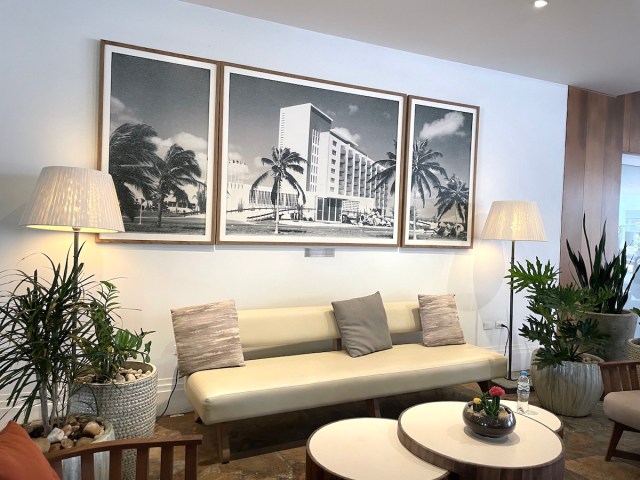
Designed by celebrated hotel architect Morris Lapidus (Miami Beach’s famous Fontainebleau is also his work) the resort occupies 15 acres on the white sands of Palm Beach—the largest and widest stretch on the beach. Features include an airy and expansive lobby that beautifully blends indoor and outdoor space; the Sunset Grille, an excellent upscale steakhouse, and decor including oversized photos capturing at once the hotel’s groovy 1960s vibe and singular legacy. Cementing the property’s place in Aruba history is the fact that the official cocktail of the island, the “Aruba Ariba,” was in fact invented at a mixology competition held here. (A photo of the original recipe scrawled on a cocktail napkin in the hand of its creator Jocky Tromp is proudly displayed at one of the bars.)
The hotel offers lots of activities for kids and families (many of them included with your stay). Options include games like ping-pong, bocce and corn hole; cupcake decorating, beachside s’mores, and beach marble races. Kayaks can be rented for a reasonable $30/hour and the use of cruising bikes is complimentary. The resort has two pools with a gradual slope entrance (great for tiny swimmers) and there’s plenty of room—we never saw an over-crowded pool.
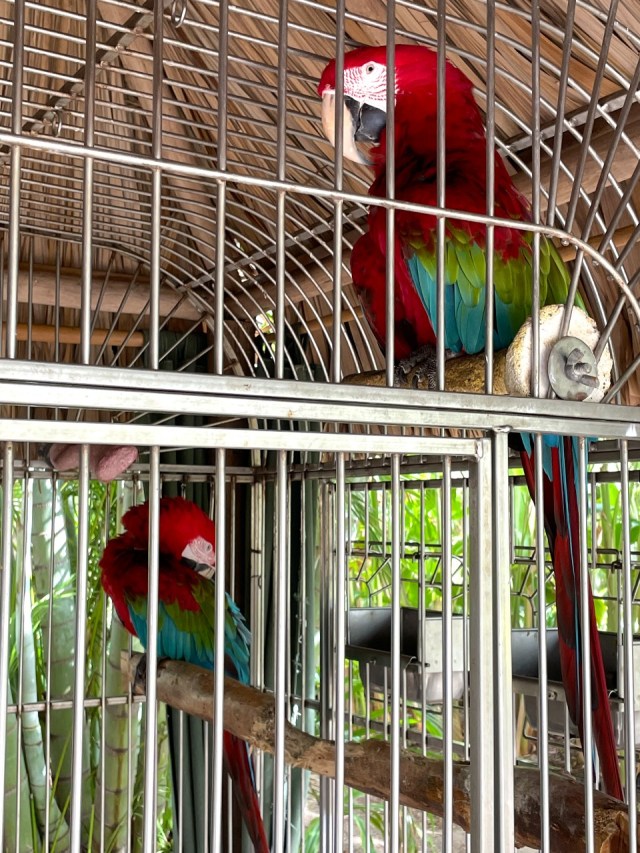
One of our favorite elements of the Hilton Aruba is the Bird Garden where almost a dozen rescued birds are cared for by a resident “Bird Whisperer.” Stop by the Bird Garden any time to say hello and read about the residents, or join the caretaker at 11 a.m. six days a week to learn about the birds and get a photo op. (FYI: Harmless iguanas and cute little lizards can also be spotted around the resort.)
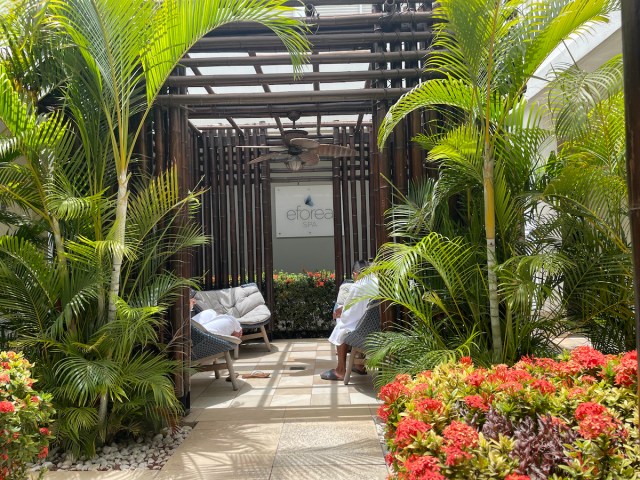
Adults can indulge in a treatment at the serene eforea spa, which offers massages of all kinds, body scrubs, facials and beauty treatments. (Tip: hit “Spa Happy Hour” from 5-6 p.m. for a complimentary add-on treatment up to $25 or 10 percent off your service. Also: If you can, book your treatment with Albert.)
Grownups can also try their luck at the on-site Hilton Aruba Casino, a frequent stop on the World Series of Poker circuit.
On vacation but still need to get some work done? Live the dream and plug in on the beach at one of the hotel’s “Power Palapas,” where not only can you get power and wifi, but are also provided with a laptop cooling pad, a sunshade privacy cover and the hydrating beverage of your choice. (Reserve one for $49.)
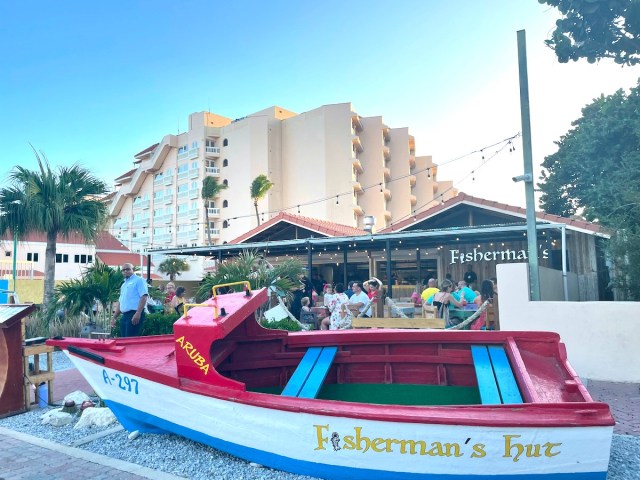
Where to Eat
You can go casual or upscale here. Stroll down J.E. Irausquin Boulevard for lots of choices including Fisherman’s Hut (excellent seafood dishes al fresco and bites for kids), hit the Gelatissimo Bus for the island’s premier gelato and be sure to taste one of the island’s specialties, the Dutch pancake—which is more like a crepe and excellent for breakfast. We recommend Linda’s Dutch Pancakes or Diana’s Pancake Place.)
For fresh and casual poke bowls, tacos, Aruban specialties and more beachside, try Gilligan’s Seafood Shack, get solid Mexican at the festive Lola Taqueria and feast on traditional Italian under the massive canopy of Gianni’s Ristorante Italiano.
This trip was paid for by the Hilton Aruba Caribbean Resort & Casino, but all opinions expressed here belong to the writer.
RELATED STORIES:
The Very Best Family Travel Blogs to Bookmark Now
17 Low-Key Beach Towns You Need to Visit & Where to Stay When You Do)
Quality Time: This Turks & Caicos Resort Is the Luxury Escape Your Family Will Love
